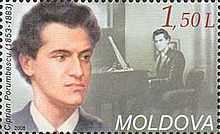Ciprian Porumbescu
| Ciprian Porumbescu | |
|---|---|
 | |
| Born |
Ciprian Gołęmbiowski October 14, 1853 |
| Died |
June 6, 1883 (aged 29) Stupca (now Ciprian Porumbescu, Suceava County, Romania) |
| Era | Romantic |


Ciprian Porumbescu (Romanian: [t͡ʃipriˈan porumˈbesku]; born Ciprian Gołęmbiowski on October 14, 1853 – June 6, 1883) was a Romanian composer born in Şipotele Sucevei in Bukovina (now Shepit, Putyla Raion, Ukraine). He was among the most celebrated Romanian composers of his time; his popular works include Crai nou, Trei culori, Song for the 1st of May, Ballad for violin and piano, and Serenada. In addition, he composed the music for Pe-al nostru steag e scris Unire, which was used for Albania's national anthem, Hymni i Flamurit. His work spreads over various forms and musical genres, but the majority of his work is choral and operetta.
Biography
Ciprian Porumbescu was born into the family of Iraclie Porumbescu, an ethnic Romanian writer and Orthodox priest of Romanian origins, whose Romanian name was changed by Austrian authorities into Golembiovski. The name Porumbescu was changed from Golembiovski in 1881 when Ciprian was at school in Suceava. He studied music in Suceava and Cernăuţi, then continued at the Konservatorium für Musik und darstellende Kunst in Vienna from 1879 to 1881 under Anton Bruckner and Franz Krenn. His artistic career as a composer, conductor, violinist, and pianist started in Cernăuţi, and continued in Vienna, and later in Braşov where he taught vocal music at Romanian schools.
Ciprian Porumbescu wrote poetry, lyrics and press articles, and actively participated in the public cultural life. He helped the rise of the Romanian music school during an age of enthusiasm generated by Romania's independence. Some of the most remarkable musical pages of the composer were inspired by national heroes and great army leaders, such as Stephen III of Moldavia and Dragoş Vodă. The appreciation of his music came from the melodic nature of his compositions and their folklore inspiration.[1]
In 1877, Porumbescu was arrested by the Austrian authorities due to his political ideals of independence manifested within the Arboroasa society; during detention, he contracted tuberculosis. He was released later after being found not guilty,[2] going on to become a founding member of Societatea Academică Junimea. He died at the age of 29 in Stupca, which was renamed Ciprian Porumbescu in his honor.
Ciprian Porumbescu left a legacy of more than 250 works, bringing him fame and popularity through his short life. The composer saw his work Crai Nou (New Moon) performed in Braşov, while his vocal works Pe-al nostru steag (On our flag), Tricolorul (Three coloured), Cântec de primăvară (Spring song), Serenada, Cântecul gintei latine (Latin nation song), La malurile Prutului (On the Prut's shores), and Altarul manastirii Putna (Putna monastery's altar) were already in the public conscience.[3]
Major works
Crai Nou
As a student at the Vienna Musical Conservatory, Porumbescu noted with great interest the success of operettas by Strauss, Suppé, Offenbach and others. His supreme goal was to replace the frivolity of subject-matter in the fashionable operettas with a plot that revived old Romanian traditions. Among them was Crai Nou (New Moon), in which the new-born moon will fulfill every lover's dreams of happiness (collected and published by Vasile Alecsandri), appeared the most appropriate for the dream-like environment of the local and earnest task he had in mind. The result was Romania's first operetta of the same name.
Ballad for Violin and Orchestra
Finished on October 21, 1880, the Ballad for Violin and Orchestra soon became the best known work by Ciprian Porumbescu, and a reference work in Romanian classical music of the 19th century. In seclusion at Stupca, the composer meditated, drafted and then finished the piece, full of poetry and bitter nostalgia, with light and shade, a mixture of "doina", old dance and song, everything in the environment of serene melancholy.
References
- ↑ Viorel Cosma, Muzicieni din România: P-S, Editura Muzicală, 1989, p.120
- ↑ Composer Ciprian Porumbescu
- ↑ Constantin Ghiban, Cînta la Stupca o vioară. Editi̧a a II-a, Bucharest, 1961.
External links
| Wikimedia Commons has media related to Ciprian Porumbescu. |
- Biography at compendium.ro (Romanian)
- Balada
- Ciprian Porumbescu's House - video
- Examples of some of his works at Myspace
|